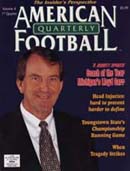AMERICAN FOOTBALL MONTHLY THE #1 RESOURCE FOR FOOTBALL COACHES
Article CategoriesAFM Magazine
|
UConn's Bracket and Vice Defensive Techniquesby: Nick RaponeDefensive Coordinator, University of Connecticut © More from this issue We play different types of man coverage with our nickel package. The advantages of this coverage are that we can take away our opponent's number one receiver, or the number one route they run. Bracket Coverage In bracket coverage, we double the number two receiver from a horizontal viewpoint, meaning we will find his release and then react. In Diagram 1, you will see the initial alignment of the two defensive backs. The inside defensive back (free safety) will be 10 yards deep, aligned two yards outside the offensive tackle. The outside defensive back (nickel) will be eight yards from the line of scrimmage, aligned on the outside shoulder of the wide receiver. From this alignment, there are three basic releases the de....The full article can only be seen by subscribers.
|
|
|||||||
| HOME |
MAGAZINE |
SUBSCRIBE | ONLINE COLUMNISTS | COACHING VIDEOS |
Copyright 2025, AmericanFootballMonthly.com
All Rights Reserved





